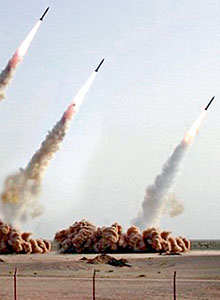Iran plans to send a monkey into space after yesterday sparking massive security fears by launching a missile to carry a second satellite into orbit.
The country's top space official Hamid Fazeli announced the plans at the launch of the Rassad-1 satellite to produce detailed maps of the earth.
'The Kavoshgar-5 rocket will be launched during the month of Mordad (July 23 to August 23) with a 285-kilogramme capsule carrying a monkey to an altitude of 74 miles,' said Fazeli, head of Iran's Space Organisation.
In February, President Mahmoud Ahmadinejad unveiled a space capsule designed to carry a live monkey into space, along with four new prototypes of home-built satellites the country hopes to launch before March 2012.
 |
| Missile tests a success, says Teheran |
At the time, Fazeli touted the launch of a large animal into space as the first step towards sending a man into space, which Tehran says is scheduled for 2020.
Iran sent small animals into space -- a rat, turtles and worms -- aboard its Kavoshgar-3 rocket in 2010.
Fazeli also announced plans for the launch in October of the Fajr reconnaissance satellite with 'a life span of a year and a half, and to be placed at an altitude of 400 kilometres,' the website reported.
This week, the Islamic republic successfully put its Rassad-1 (Observation-1) satellite into orbit 260 kilometres above the Earth.
The move raised fears surrounding Iran's nuclear activity as the technology could also be used to fire powerful nuclear warheads.
There was no independent confirmation of the launch or of the satellite achieving orbit, which was first reported by State TV. It would be the second satellite Iran has put into orbit. The first, named Omid, was launched in 2009.
Rassad-1, which orbits the Earth 15 times every 24 hours and has a two-month life cycle, will be used to photograph the planet and transmit images, media reports said.
Originally scheduled to launch in August 2010, the satellite was built by Malek Ashtar University in Tehran, which is linked to Iran's elite Revolutionary Guards.
Iran's decade-long space programme has raised alarms in the West because the same technology that allows missiles to launch satellites can be used to fire warheads.
Israel, the US and others claims that Iran is trying to develop nuclear weapons but the country's predident, Mahmoud Ahmadinejad, denies that.
The TV report said the Rasad satellite, developed by Iran's aerospace agency, weighs 34lb and has been designed to orbit the earth 15 times a day at the height of 160 miles.
'Our glorious scientists successfully put Iran's first image-collecting satellite into orbit,' the TV report said.
Iran has made a series of claims about advances in its ambitious space programme in recent years, which has Western powers worried about the possibility of its military applications.
Iran's space programme has expressed a goal of putting a man in orbit within 10 years, despite the expense and technological challenge involved.
Iran is showcasing its technological successes as signs it can advance despite the threat of US and UN sanctions over its nuclear programme.
It is also pressing ahead with its military missile programme, frequently testing missiles capable of reaching Israel, US bases in the Gulf and parts of south east Europe.
Iran launched its first commercial satellite in 2005 on a Russian rocket. Russia, North Korea and China transfer space technology to Iran.
Iran has said it wants to put its own satellites into orbit to monitor natural disasters in the earthquake-prone nation and improve its telecommunications.
Iranian officials also point to America's use of satellites to monitor conflicts in Afghanistan and Iraq and say they need similar capabilities for their security.
© Daily Mail, London |


